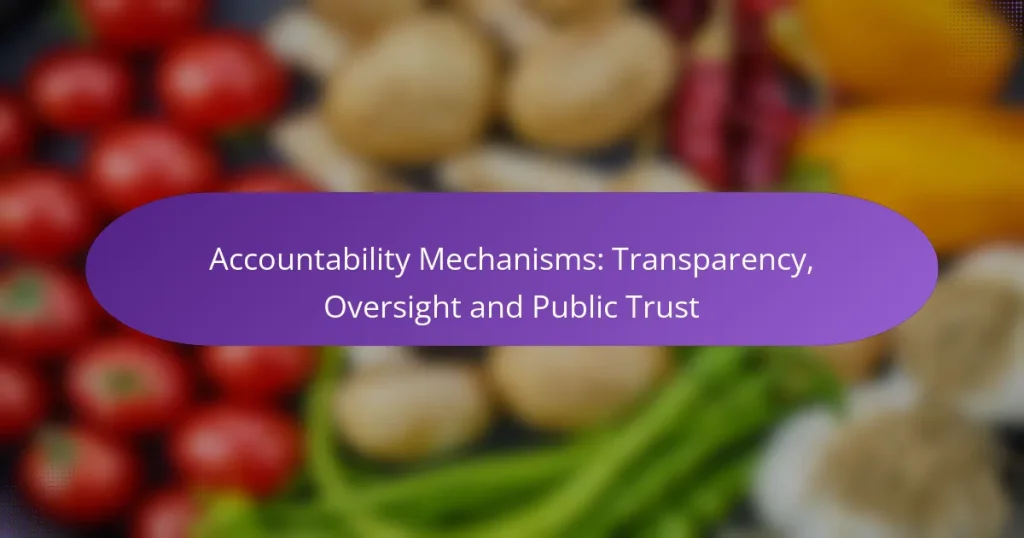Accountability mechanisms play a crucial role in enhancing public trust by promoting transparency and responsible governance. By implementing practices such as regulatory frameworks, audits, and public reporting, organizations can foster a culture of openness that allows citizens to engage with and scrutinize decision-making processes, ultimately reinforcing confidence in institutions.

How Do Accountability Mechanisms Enhance Public Trust?
Accountability mechanisms enhance public trust by ensuring that organizations and governments act transparently and responsibly. By fostering a culture of openness and responsibility, these mechanisms help build confidence among citizens regarding the integrity of decision-making processes.
Increased transparency
Increased transparency involves making information accessible and understandable to the public. This can include publishing budgets, decision-making processes, and performance metrics, allowing citizens to see how resources are allocated and decisions are made.
For example, local governments may publish their spending reports online, enabling residents to track how taxpayer money is used. This openness can deter corruption and encourage responsible behavior from public officials.
Effective oversight
Effective oversight ensures that actions taken by organizations or governments are monitored and evaluated regularly. Independent bodies, such as audit committees or regulatory agencies, play a crucial role in this process by reviewing practices and ensuring compliance with laws and regulations.
For instance, in the European Union, various agencies oversee compliance with financial regulations, helping to maintain standards and protect public interests. Regular audits and assessments can identify areas for improvement and hold entities accountable for their actions.
Community engagement
Community engagement involves actively involving citizens in decision-making processes, fostering a sense of ownership and responsibility. This can be achieved through public consultations, town hall meetings, or participatory budgeting initiatives.
By engaging the community, organizations can gather diverse perspectives and build trust. For example, a city might hold workshops to discuss new policies, allowing residents to voice their opinions and influence outcomes directly.
Improved decision-making
Improved decision-making results from incorporating feedback and data into the process. Accountability mechanisms encourage organizations to consider public input and evidence-based practices when making decisions, leading to more effective outcomes.
For example, a government may analyze public health data and community feedback to develop targeted health initiatives, ensuring that resources are allocated where they are most needed. This approach not only enhances effectiveness but also builds trust in the decision-making process.
Accountability in governance
Accountability in governance refers to the responsibility of public officials to act in the best interests of their constituents. Mechanisms such as performance evaluations, citizen feedback systems, and legal frameworks help ensure that officials are held accountable for their actions.
In many countries, laws require public officials to disclose conflicts of interest and adhere to ethical standards. This accountability fosters trust, as citizens can be assured that their leaders are acting transparently and responsibly in their roles.

What Are the Key Types of Accountability Mechanisms?
Key types of accountability mechanisms include regulatory frameworks, audits and evaluations, public reporting, and stakeholder feedback. These mechanisms are essential for ensuring transparency, oversight, and building public trust in various organizations and institutions.
Regulatory frameworks
Regulatory frameworks establish the rules and guidelines that organizations must follow to ensure accountability. These frameworks can vary by industry and region, often incorporating local laws and international standards.
For example, financial institutions in the European Union must adhere to the MiFID II regulations, which promote transparency and protect investors. Organizations should regularly review and update their compliance with these frameworks to maintain accountability.
Audits and evaluations
Audits and evaluations are systematic assessments of an organization’s processes, finances, and performance. They help identify areas for improvement and ensure that resources are used effectively.
Organizations often conduct internal audits annually, while external audits may occur every few years. It’s crucial to act on the findings from these audits to enhance accountability and public trust.
Public reporting
Public reporting involves sharing information about an organization’s activities, finances, and outcomes with stakeholders and the general public. This transparency fosters trust and allows for informed decision-making.
Common forms of public reporting include annual reports, sustainability reports, and financial statements. Organizations should ensure that these reports are accessible and understandable to their audience.
Stakeholder feedback
Stakeholder feedback is the process of gathering input from individuals or groups affected by an organization’s actions. This feedback is vital for understanding public perceptions and improving accountability.
Methods for collecting feedback can include surveys, focus groups, and public forums. Organizations should actively seek and respond to this feedback to demonstrate their commitment to accountability and transparency.

How Do Transparency Practices Affect Oversight?
Transparency practices significantly enhance oversight by allowing stakeholders to scrutinize actions and decisions. When information is openly shared, it fosters accountability and builds public trust in institutions.
Enhanced scrutiny
Enhanced scrutiny arises when transparency practices provide stakeholders with the necessary information to evaluate the actions of organizations or governments. This increased visibility allows for better monitoring of compliance with regulations and ethical standards.
For example, public access to financial reports and decision-making processes enables citizens and watchdog organizations to identify discrepancies or potential misconduct. Regular audits and open meetings can further strengthen this scrutiny.
Informed public participation
Transparency encourages informed public participation by equipping citizens with the knowledge required to engage in discussions and decision-making processes. When people have access to relevant data, they can voice their opinions and contribute meaningfully to policy debates.
For instance, community forums that share information about local projects allow residents to provide feedback and influence outcomes. This participatory approach can lead to more representative and effective governance.
Data accessibility
Data accessibility is crucial for effective oversight, as it ensures that stakeholders can easily obtain and analyze information. Open data initiatives, which make datasets available to the public, empower citizens to investigate issues and hold authorities accountable.
Governments can implement user-friendly platforms to share data on budgets, spending, and performance metrics. This accessibility not only fosters transparency but also encourages innovation, as citizens and organizations can use the data to develop solutions to community challenges.

What Role Does Technology Play in Accountability?
Technology plays a crucial role in enhancing accountability by providing tools for transparency, oversight, and public engagement. Through innovations like blockchain, data analytics, and digital platforms, organizations can foster trust and ensure responsible governance.
Blockchain for transparency
Blockchain technology offers a decentralized and immutable ledger that enhances transparency in various sectors. By recording transactions in a way that is accessible and verifiable, stakeholders can track the flow of funds or data without relying on a central authority.
For instance, in supply chain management, blockchain can provide real-time visibility into the sourcing and movement of goods, allowing consumers to verify claims about sustainability or ethical practices. Organizations should consider implementing blockchain solutions that align with their operational needs and regulatory requirements.
Data analytics for oversight
Data analytics enables organizations to monitor activities and detect anomalies that may indicate misconduct or inefficiencies. By analyzing large datasets, entities can identify patterns and trends that inform decision-making and enhance accountability.
For example, government agencies can use data analytics to assess the effectiveness of public programs and allocate resources more efficiently. It is essential to establish clear metrics and benchmarks to guide the analysis, ensuring that insights lead to actionable improvements.
Digital platforms for public engagement
Digital platforms facilitate public engagement by providing channels for citizens to voice concerns, access information, and participate in decision-making processes. These platforms can enhance accountability by making government actions more visible and accessible to the public.
Examples include online portals for reporting issues or providing feedback on public services. Organizations should prioritize user-friendly interfaces and ensure that engagement tools are widely promoted to maximize participation and foster trust within the community.

How Can Organizations Implement Effective Accountability Mechanisms?
Organizations can implement effective accountability mechanisms by establishing clear policies, training staff on compliance, and utilizing technology solutions. These steps foster transparency, enhance oversight, and build public trust.
Establish clear policies
Clear policies are essential for accountability as they outline expectations and responsibilities. Organizations should develop comprehensive guidelines that cover ethical behavior, reporting procedures, and consequences for non-compliance.
Regularly reviewing and updating these policies ensures they remain relevant and effective. Engaging stakeholders in the policy development process can also enhance buy-in and adherence.
Train staff on compliance
Training staff on compliance is crucial for ensuring everyone understands the accountability mechanisms in place. Organizations should provide regular training sessions that cover policies, ethical standards, and reporting processes.
Consider using a mix of training methods, such as workshops, e-learning modules, and scenario-based exercises. This approach helps reinforce the importance of accountability and prepares staff to act appropriately in various situations.
Utilize technology solutions
Technology solutions can streamline accountability mechanisms by automating processes and enhancing transparency. Tools such as compliance management software can help track adherence to policies and facilitate reporting.
Implementing data analytics can also provide insights into compliance trends and areas for improvement. Organizations should ensure that any technology used complies with relevant regulations and is user-friendly to promote widespread adoption.

![[censured] Rights Movements: Influence on Democratic Policies](https://koshimo.net/wp-content/uploads/featured-image-lgbtq-rights-movements-influence-on-democratic-policies-150x150.webp)
